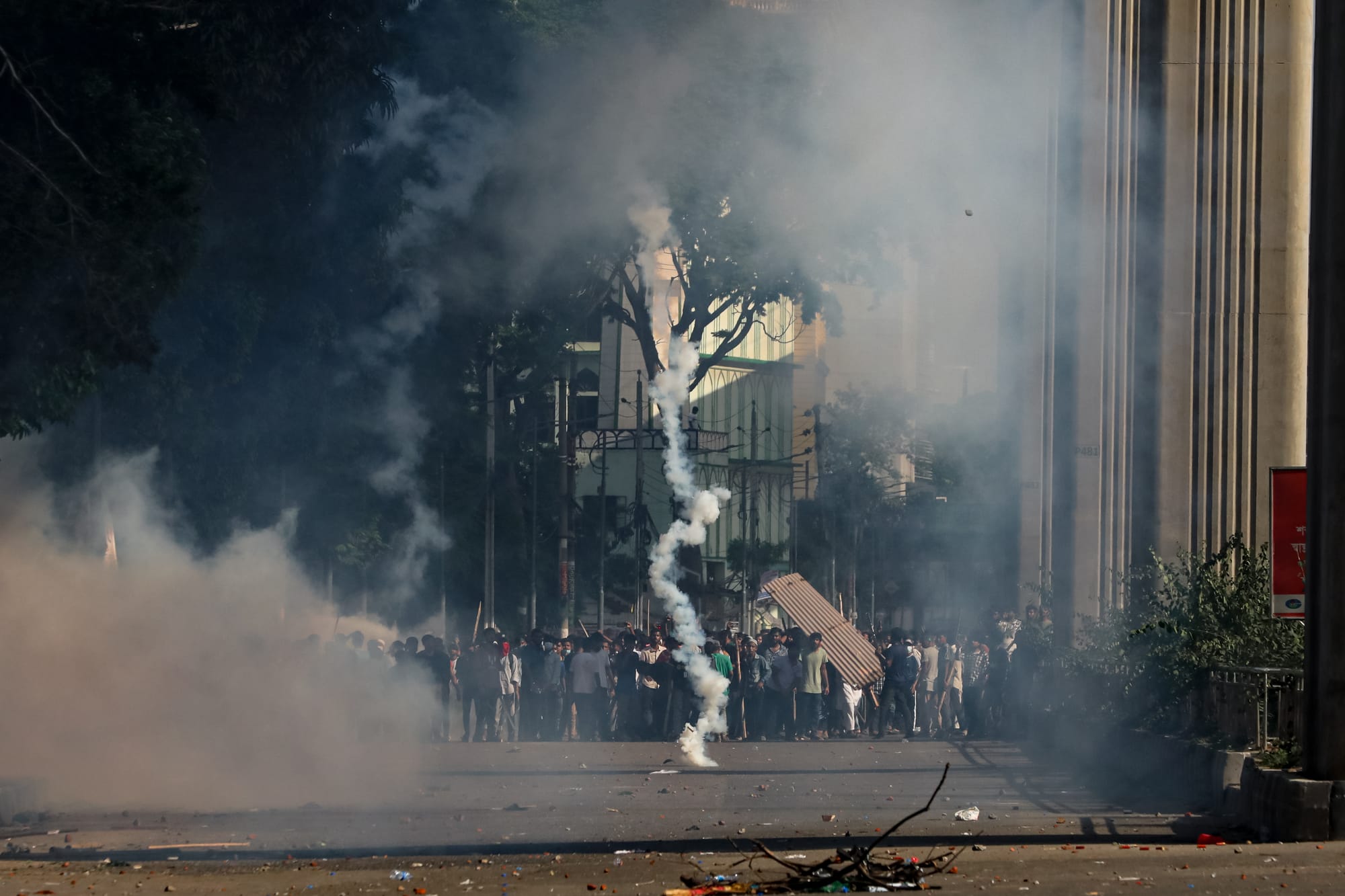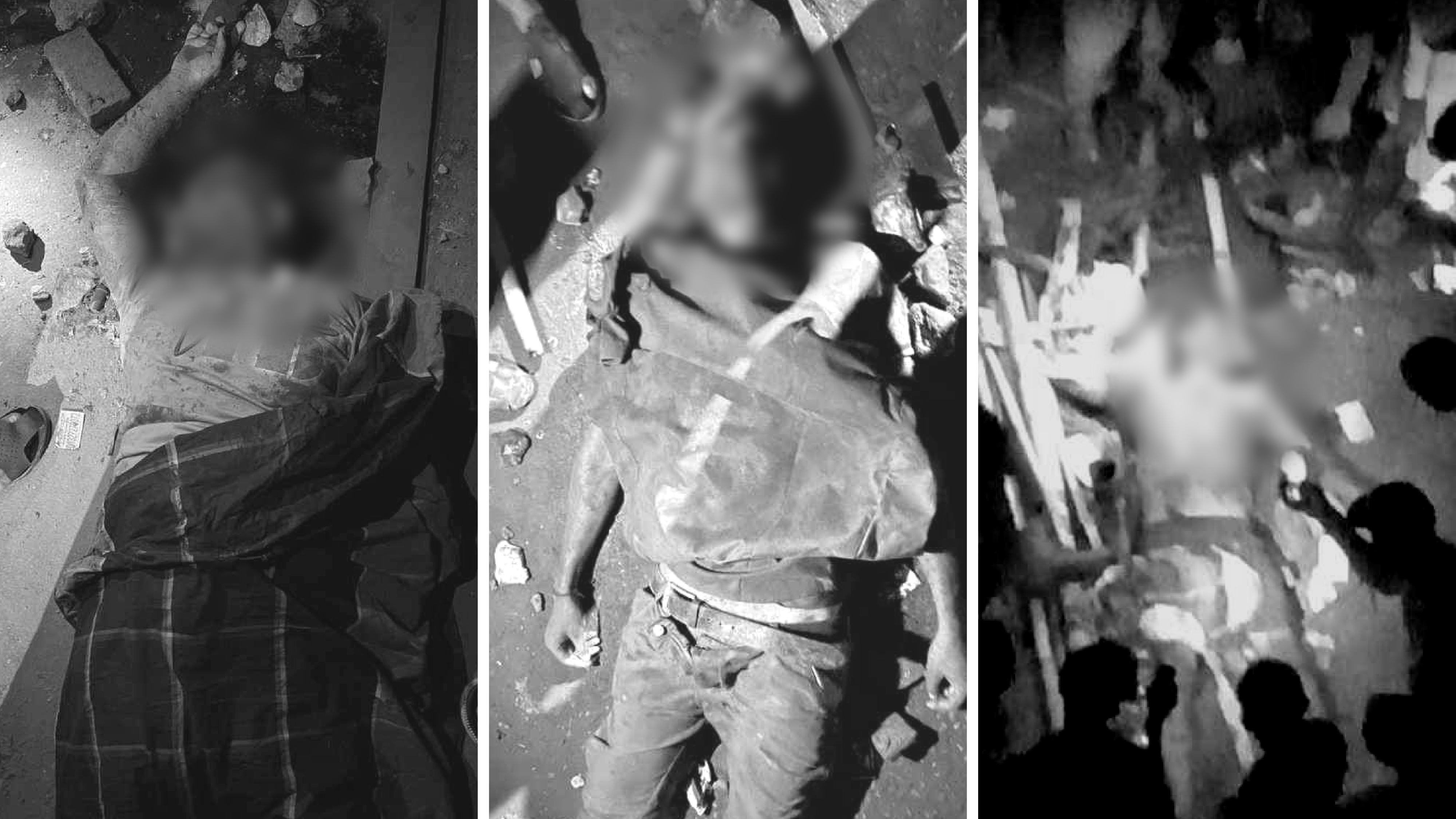An eye-witness account from inside Jatrabari Police Station of the last bloodbath
As Hasina fled, Jatrabari became a killing field with police firing indiscriminately, enraging marchers toward her residence. The mob burned down the station, resulting in six policemen killed. A witness from the station's lock-up recounts the bloodbath from inside.

On the morning of August 5th 2024, murmurs of Sheikh Hasina fleeing in the face of a mass uprising filled the air. People demanding her removal gathered around the Jatrabari intersection to march towards her official residence, Gono Bhaban. One of them was Karimul Islam, a worker at a Jatrabari street shop.
Just before 2 p.m., Karimul was seen running away as police in full riot gear kept firing at him in a video shared on social media. Karimul fell to the ground. He died on September 30th at a Dhaka hospital after fighting for his life for nearly two months, ultimately succumbing to the bullet wounds inflicted on him. Local media reports claim there were more than 30 fatalities due to the indiscriminate firing of the police on that day in Jatrabari, but the total body count is yet to be confirmed. To date, Karimul is the latest casualty.
When Karimul was running for his life, a student from a private university, Sakhawat, was inside the jail on the first floor of Jatrabari Police Station, placed right in front of an armoury.
“We could see them reloading their Chinese rifles and the guns that use rubber bullets (shotguns) in front of us. Some of them looked like AK-47s. And then we started hearing non-stop gunshots from outside,” said Sakhawat.
Sakhawat was among the 22 inmates in Jatrabari Police Station’s lock-up on the fateful day of August 5th. He spoke to Netra News in early October and narrated what he saw from inside the station. His story, since verified by Netra News, gives the intricate details of the events inside the station during those harrowing hours as Jatrabari turned into a killing field.
Landing in jail
Sakhawat became active in the protest on July 18th, the day on which the Hasina administration enforced a crackdown on protesters and started shooting at them with lethal weapons. He continued his fight in the Badda and Pragati Sharani areas for the next two days but was forced to return to his village home when the government deployed the army and declared curfew with “shoot-at-sight” orders.
“I was feeling restless, wanting to resume protesting in Dhaka,” he said. “So I decided to return to Dhaka. My parents even made me take sleeping pills to keep me at home.”
However, when the one-point demand for Hasina’s resignation was made on August 3rd, he boarded a passenger ferry, came to Dhaka alone the following day, and went to his aunt’s home in Demra.
“I had friends in that area, and when the March for Dhaka was rescheduled for August 5th, we decided to gather at Gulistan the next day and march to Gono Bhaban,” Sakhawat said.
But things changed when he was intercepted by the police at around 9 a.m. on August 5th and taken to Jatrabari Police Station for a thorough search. “I took a rickshaw in the morning. While passing Shonir Akhra, police stopped me and asked for my phone to check it. Then they took me to the police station to search my phone.”
After arriving at the station, he was thoroughly searched, his mobile phone was confiscated, and after hurling abuse at him, the police locked him inside the jail. He described the cell as a small, dark room surrounded by iron bars and metal nets, with an open toilet in the middle.
Sakhawat continues, “It had barely enough space for two to three people, but when I entered, there were 22 people altogether.”
Most of the inmates in the lock-up, according to him, were from local madrasas, most likely Hefazat-e-Islam activists, and at least one of them was tortured during the previous night to the extent that he lost consciousness and was lying on the floor. “They [police officials] threatened to torture all of us that night,” he said.
The bloodbath
By noon, the police stationed at Jatrabari were unleashed on the people gathered around the area. Before that, they prepared themselves by equipping themselves with riot gear and reloading all their weapons. Sakhawat and the other inmates who were inside the jail could see everything.
“We could see them loading their Chinese rifles, pistols and guns that use rubber bullets (shotguns) in front of us. Some of them looked like AK-47s. And then we started hearing non-stop gunshots from outside,” Sakhawat narrates. He said policemen were asking for Chinese rifles from their colleagues in the armoury.
Chinese Type 56 rifles are a variant of AK-47 rifles that originated from Russia and are widely used by Bangladesh’s police. Netra News shared photographs of Type 56 semi-automatic rifles with Sakhawat. He identified them as the ones he saw at Jatrabari Police Station.
According to Sakhawat, the bullets they were loading in the Chinese rifles were two to three inches long. His narration matches the description of 7.62×39mm bullets, typically around 2.20 inches long, used by the police with Chinese-made Type 56 rifles. Netra News shared images of these bullets, which he identified as the bullets used by the police in Jatrabari.
Sakhawat claimed that he heard continuous firing from outside, and soon, the whole area was filled with the smell of gunpowder and tear gas.
Policemen at the station were working in a synchronised manner during the massacre. While one group was shooting at protesters, another group came upstairs to reload guns, following which they would go outside to replace their colleagues whose weapons would run out of bullets by then.
However, when the people mobilised and retaliated, the policemen started verbally abusing the inmates.
“They were also aiming guns at us [...] they were venting their anger at us,” said Sakhawat. They even threatened to kill them in staged crossfires and burst fire.
Hasina’s betrayal
It was after 3 p.m. when the police in Jatrabari found out that their leader, Hasina, whom they were desperate to protect, had fled to India.
“The policemen there were saying, ‘Sheikh Hasina has fled, we can’t stay here now,’” Sakhawat overheard them speaking.
Meanwhile, when the policemen inside the station were guarding the armoury, their colleagues and senior officials on the streets departed without notifying them, leaving them almost unguarded.
Around 4 p.m., when some of the policemen tried to escape through the main gate of the station, they were seized by the mob and beaten mercilessly. Seeing this, the remaining policemen still on the station’s first floor feared for their lives, according to Sakhawat.
By then, the angry mob had torched the vehicles around the police station. Fire raged inside the station, too. It was engulfed in black smoke, and the waiting mob made it impossible for the stranded policemen to make their way to the road. Hence, they decided to co-operate with the inmates and made an offer.
“If I save you, will you save me?” said one policeman stuck inside the station. The idea was to help the policemen escape, wearing the inmates’ clothes, in exchange for opening the jail’s gate.
When they agreed, the policeman shot the gate’s lock twice and then broke it by striking it with a piece of wood. The inmates helped the policemen to dress up like commoners.

A close call with death
As the fire overwhelmed the building, the policemen, dressed up as commoners shorn of their uniforms, tried to flee the station along with the inmates. Seeing an angry crowd waiting outside the gate, they climbed over the wall to a nearby building on the other end of the station, far from the gate.
“I climbed over the wall to the first floor of a building, then went to another building’s second floor,” Sakhawat explained how he came out of the police station’s compound that day. “But when I came down, jumping out of the building, an angry mob nabbed me to beat me up,” Sakhawat said.
Assuming he was a policeman in disguise trying to escape from the station, the angry mob was about to strike Sakhawat, but the ill luck that had befallen him all day miraculously turned.
Fearing for his life, Sakhawat was desperately trying to prove that he was a fellow protester who had participated in the protests since July 18th. A student from the Canadian University of Bangladesh, who was part of the crowd and had taken part in the protest in the Badda area on July 18th, came to his rescue. He testified on his behalf and took him to a safe place.
Others, especially the policemen in civilian attire, were not as fortunate. While he could not confirm what happened to all of them that day, a list released by the interim government confirmed six policemen died on that day around Jatrabari Police Station.
With the station ablaze, corpses of policemen were lying on the ground outside.●